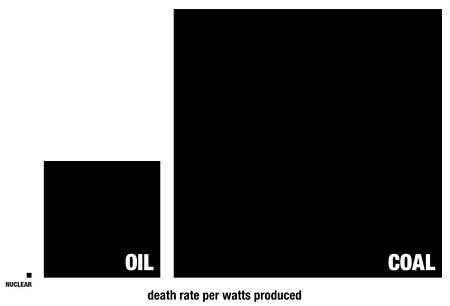Posts Tagged ‘nuclear safety’
Causa Mortis…
It’s no wonder, what with Fukushima and all, that there’s renewed worry about the safety of nuclear power. As that tragic episode demonstrates, it’s an altogether justified concern. But what of the alternatives?
The Lifeboat Foundation‘s Next Big Future did the homework, quantifying the inclusive mortality rates from the use of coal, oil, natural gas, biomass/biofuel, peat, solar, wind, hydro, and nuclear to generate electricity. The detailed results, with supporting research, are here; that detail is graphically portrayed here…
By way of putting nuclear into context, Seth Godin summarizes the comparison:

There are objections one might raise to the research used (it doesn’t, for instance, take into account the implications of the long half-lives of radioactive contaminants, nor less-than- or indirectly-fatal effects like impact on the endocrine system). But in any case, the point is not, of course, that one shouldn’t be concerned with nuclear safety; the events of the last couple of weeks are ample evidence that it’s critical.
Rather (and graphically obviously) the point is that one should be even more concerned about– and active in addressing– the risks of fossil fuel generation.
The title of Seth’s post: “The triumph of coal marketing.” Indeed.
As we hustle to harness the wind, we might might recall that it was on this date in 1855 that Canadian physician, geologist, and inventor Abraham Gesner received the first U.S. patent for a process to obtain oil from bituminous shale and cannel coal for the purpose of illumination (No. 12,612); he called the product “kerosene.”
What’s Up, Doc?…
Radioactive rabbit trapped near Richland
A radioactive rabbit caught at Hanford [see here] just north of Richland had Washington State Department of Health workers looking for contaminated droppings Thursday…
[Hanford was] used during the Cold War for testing highly radioactive materials, particularly fuel elements and cladding that were irradiated at Hanford reactors as part of plutonium production for the nation’s nuclear weapons program…
Liquid waste with radioactive salts was discharged into the ground near central Hanford during the Cold War. Rabbits and other animals were attracted to the salts and spread radioactive droppings across as much as 13.7 square miles of sage-covered land before the waste sites were sealed to keep out animals in 1969. Federal economic stimulus money has been used to survey for the radioactive hot spots that remain four decades later.
In a more recent case, so many radioactive wasp nests were found spread across six acres by H Reactor in northern Hanford that up to a foot of soil was dug up to remove the nests. The nests were built by mud dauber wasps in 2003. Water was sprayed to control dust during demolition of a basin attached to the reactor, and the mud created was collected by the wasps to build nests under straw that had been spread nearby to protect newly planted sagebrush seedlings.
There have been a couple of cases in the past two decades of contaminated animals in areas where they potentially could come in contact with the public. In 1996, a contaminated mouse apparently crawled into a box of food collected by an employee food drive in central Hanford. It was trapped and tested in an abandoned Hanford building previously used by the Tri-Cities Food Bank.
Two years later, gnats and flies were suspected of eating a sugary coating used to fix some radioactive contamination. They then spread the contamination to waste left by workers in offices, such as banana peels and apple cores. That required 35 tons of trash that could contain the office waste to be dug up from the Richland landfill and returned to Hanford.
Read the full story at Tricityherald.com (and more, here or here).
As we contemplate the prospect of Easter egg hunts after dark, we might recall that it was on this date in 1989 that a failing east German regime opened the Berlin Wall, allowing free East-West passage. A few weeks earlier Hungarian officials had opened the border between Hungary and Austria, effectively rendering the Berlin Wall redundant, as East German citizens could then circumvent it by going through Hungary into Austria, and thence into West Germany. Virtually immediately, Germans on both sides began to demolish the Wall.
 Germans climbing the Wall at the Brandenburg Gate in celebration of its demise (source)
Germans climbing the Wall at the Brandenburg Gate in celebration of its demise (source)


You must be logged in to post a comment.